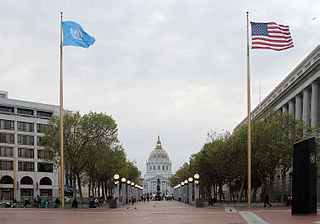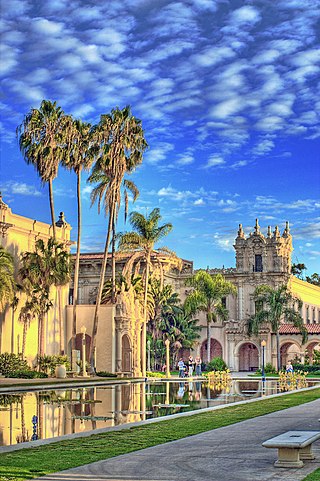
A world's fair, also known as a universal exhibition or an expo, is a large international exhibition designed to showcase the achievements of nations. These exhibitions vary in character and are held in different parts of the world at a specific site for a period of time, typically between three and six months.

The Presidio of San Francisco is a park and former U.S. Army post on the northern tip of the San Francisco Peninsula in San Francisco, California, and is part of the Golden Gate National Recreation Area.

The Panama–Pacific International Exposition was a world's fair held in San Francisco, California, United States, from February 20 to December 4, 1915. Its stated purpose was to celebrate the completion of the Panama Canal, but it was widely seen in the city as an opportunity to showcase its recovery from the 1906 earthquake. The fair was constructed on a 636 acre(1 sq. mi., 2.6 km2) site along the northern shore, between the Presidio and Fort Mason, now known as the Marina District.

The Palace of Fine Arts is a monumental structure located in the Marina District of San Francisco, California, originally constructed for the 1915 Panama–Pacific International Exposition to exhibit works of art. Completely rebuilt from 1964 to 1974, it is the only structure from the exposition that survives on site.

The Civic Center in San Francisco, California, is an area located a few blocks north of the intersection of Market Street and Van Ness Avenue that contains many of the city's largest government and cultural institutions. It has two large plazas and a number of buildings in classical architectural style. The Bill Graham Civic Auditorium, the United Nations Charter was signed in the Veterans Building's Herbst Theatre in 1945, leading to the creation of the United Nations. It is also where the 1951 Treaty of San Francisco was signed. The San Francisco Civic Center was designated a National Historic Landmark in 1987 and listed in the National Register of Historic Places on October 10, 1978.

Jackson Park is a 551.5-acre (223.2 ha) park located on the South Side of Chicago, Illinois. It was designed in 1871 by Frederick Law Olmsted and Calvert Vaux, then greatly remodeled in 1893 to serve as the site of the World's Columbian Exposition, making it one of the largest and most historically significant parks in the city. Some features attest to the legacy of the fair, including a Japanese garden, the Statue of TheRepublic, and the Museum of Science and Industry. As part of the Woodlawn community area, it extends along Lake Michigan and also borders the neighborhoods of Hyde Park and South Shore.

The Panama–California Exposition was a world exposition held in San Diego, California, between January 1, 1915, and January 1, 1917. The exposition celebrated the opening of the Panama Canal, and was meant to tout San Diego as the first United States port of call for ships traveling north after passing westward through the canal. The fair was held in San Diego's large urban Balboa Park. The park however also had a second Panama-California exposition again in 1935.

Bernard Ralph Maybeck was an American architect in the Arts and Crafts Movement of the early 20th century. He was an instructor at University of California, Berkeley. Most of his major buildings were in the San Francisco Bay Area.

The California Pacific International Exposition was an exposition held in San Diego, California during May 29, 1935–November 11, 1935 and February 12, 1936–September 9, 1936. The exposition was held in Balboa Park, San Diego's large central urban park, which had also been the site of the earlier Panama-California Exposition in 1915.

Highland Park is a historic park in Meridian, Mississippi, United States. Home to a museum honoring Jimmie Rodgers, a Meridian native, the site was listed on the National Register of Historic Places in 1979. The park is also home to the Highland Park Dentzel Carousel and Shelter Building, a National Historic Landmark manufactured around 1896 by Gustav Dentzel of Philadelphia, Pennsylvania. The historic carousel is the only two-row stationary Dentzel menagerie still in existence.

The House of Charm is a historic museum building in Balboa Park, San Diego. It was built for the 1915–16 Panama-California Exposition, and like most buildings from that Exposition it features Mission Revival Style architecture. It acquired its current name, "House of Charm", during the park's second Exposition held in from 1935 to 36. It now houses the San Diego Art Institute and the Mingei International Museum as well as rehearsal space for the Old Globe Theatre. It is listed on the National Register of Historic Places.

George William Kelham (1871–1936) was an American architect, he was most active in the San Francisco Bay Area.

Eames and Young was an American architecture firm based in St. Louis, Missouri, active nationally, and responsible for several buildings on the National Register of Historic Places.

The LeClaire Park Bandshell, also known as the W.D. Petersen Memorial Music Pavilion, is located on Beiderbecke Drive in LeClaire Park, Davenport, Iowa. It was listed on the National Register of Historic Places in 1983 and on the Davenport Register of Historic Properties in 1993.

The Dillon Memorial is a historic structure located in LeClaire Park, near downtown Davenport, Iowa, United States. It was listed on the National Register of Historic Places (NRHP) in 1983 and on the Davenport Register of Historic Properties in 1993. It is commonly referred to as the Dillon Fountain.

Balboa Park is a 1,200-acre (490 ha) historic urban cultural park in San Diego, California, United States. In addition to open space areas, natural vegetation zones, green belts, gardens, and walking paths, it contains museums, several theaters, and the San Diego Zoo. There are also many recreational facilities and several gift shops and restaurants within the boundaries of the park. Placed in reserve in 1835, the park's site is one of the oldest in the United States dedicated to public recreational use. Balboa Park is managed and maintained by the Parks and Recreation Department of the City of San Diego.

The Palace of Fine and Decorative Arts, also known as Building 3, on Treasure Island in San Francisco Bay, California, was an aircraft hangar constructed in 1938 for Pan American World Airways' trans-Pacific Clipper services, and then modified for the 1939-40 Golden Gate International Exposition. Building 3 was one of a pair of identical hangars built to house Pan American's flying boats at the south end of the island. Building 1 was to be the airline's terminal building, and Buildings 2 and 3 would house the aircraft. For the exposition, these buildings were converted to exhibition halls, surrounded by a complex of temporary structures. At the end of the exposition all structures but Buildings 1, 2 and 3 were to be torn down to make way for the development of the reclaimed land as an airport for San Francisco.

The California Quadrangle, California Building, and California Tower are historic structures located in Balboa Park in San Diego, California. They were built for the 1915–16 Panama-California Exposition and served as the grand entry to the Expo. The buildings and courtyard were designed by architect Bertram Goodhue. They were added to the National Register of Historic Places on May 17, 1974. They now house the Museum of Us.

The El Prado Complex is a historic district in Balboa Park in San Diego, California. The 13-acre (5.3 ha) complex includes 13 contributing buildings and one contributing structure. Most of the structures were built for San Diego's Panama-California Exposition of 1915–16 and were refurbished and re-used for the California Pacific International Exposition of 1935–36. The original architects were Bertram Goodhue and Carleton Winslow. The area was listed on the National Register of Historic Places in 1976.
William Baker Faville (1866-1946) was an American architect.



















